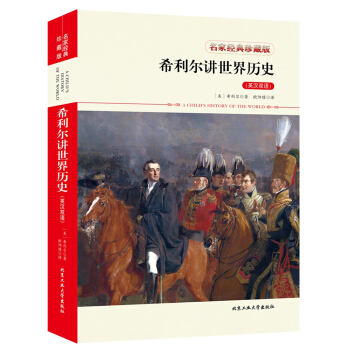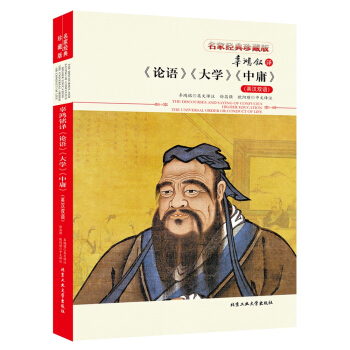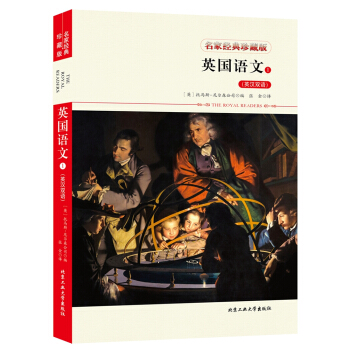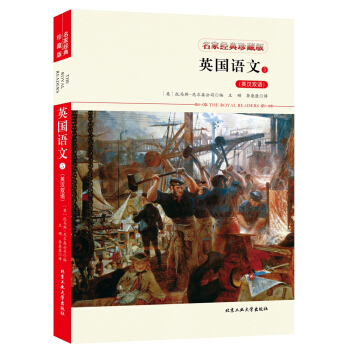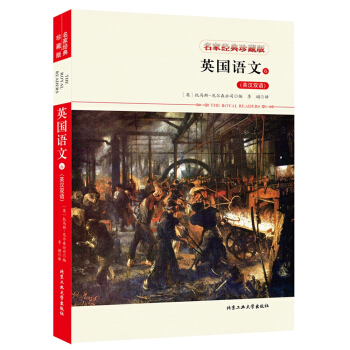

具体描述
产品特色
编辑推荐
这是继《美国语文》之后的另一套经典原版教材,了解英国人文历史、欣赏英国文学的优秀读本。全套共6册,分级编写,还附有大量插图。充满趣味的英语故事与优美的英国文学相融合,让国内学生更好地感悟英国文化历史,并真正学好英语这门语言。无论是作为英语学习的课本,还是作为提高英语水平的课外读物,这套书都很有价值。内容简介
《英国语文》这套书原名《皇家读本》,全套六册。由英国教材出版公司编写出版。在20世纪初广泛用作学校教材。编写体例统一严谨、包括生词、课文、语音、词汇解释、课后问题等,同时还附加了书写与听写等,是一套完整的英语学习教材。这些选文,体现了英国丰富的历史文化知识和西方国家的道德价值观念。是中国学生学习英语、全面了解西方社会的很好途径。作者简介
英国托马斯-尼尔森公司,主要从事各类教育著作的出版发行,本套《英国语文》即为该公司100多年前为英国的学生编纂的教材,适用范围很广,受到普遍赞誉,一直是一套深受英国小学生欢迎的教材目录
Lesson 1 THE GREAT SIEGE OF GIBRALTAR/第一课 直布罗陀大围攻 1Lesson 2 BATTLE OF CORUNNA AND DEATH OF MOORE
第二课 拉科鲁尼亚之战和莫尔爵士之死 9
Lesson 3 THE BURIAL OF SIR JOHN MOORE
第三课 约翰 莫尔爵士的葬礼 14
Lesson 4 THE BED OF THE ATLANTIC/第四课 大西洋的海床 17
Lesson 5 BINGEN ON THE RHINE/第五课 莱茵河畔的宾根 22
Lesson 6 THE CLOUD/第六课 云 朵 26
Lesson 7 THE TRIAL BY COMBAT(I)/第七课 决斗裁判(一) 32
Lesson 8 THE TRIAL BY COMBAT(II)/第八课 决斗裁判(二) 37
Lesson 9 DAMASCUS AND LONDON(I)
第九课 大马士革和伦敦(一) 45
Lesson 10 DAMASCUS AND LONDON(II)
第十课 大马士革和伦敦(二) 52
Lesson 11 BATTLE OF TRAFALGAR, AND DEATH OF NELSON(I)
第十一课 特拉法加海战和纳尔逊之死(一) 59
Lesson 12 BATTLE OF TRAFALGAR, AND DEATH OF NELSON(II)
第十二课 特拉法加海战和纳尔逊之死(二) 66
Lesson 13 ROUND THE WORLD/第十三课 环球航行 74
Lesson 14 NATURE/第十四课 自 然 85
Lesson 15 THE TROPICAL WORLD(I) /第十五课 热带世界(一) 87
Lesson 16 MAN AND THE INDUSTRIAL ARTS
第十六课 人类和工业艺术 97
Lesson 17 SOMEBODY’S DARLING/第十七课 某人的亲爱的人 103
Lesson 18 THE TROPICAL WORLD(II)/第十八课 热带世界(二) 106
Lesson 19 THE SONG OF THE SHIRT/第十九课 衬衫之歌 117
Lesson 20 LAND AND SEA BREEZES/第二十课 陆地风与海洋风 120
Lesson 21 THE RELIEF OF LEYDEN/第二十一课 莱顿市的救援 124
Lesson 22 THE GLOVE AND THE LIONS/第二十二课 手套与狮子 130
Lesson 23 THE POLAR WORLD(I)/第二十三课 极地世界(一) 132
Lesson 24 THE BELLS/第二十四课 钟 声 138
Lesson 25 THE POLAR WORLD(II)/第二十五课 极地世界(二) 141
Lesson 26 THE BURNING OF MOSCOW
第二十六课 莫斯科的大火 147
Lesson 27 THE RETREAT OF THE FRENCH ARMY FROM MOSCOW
第二十七课 法国军队从莫斯科撤退 155
Lesson 28 THE TEMPERATE REGIONS/第二十八课 温带地区 161
Lesson 29 THE OVERLAND ROUTE/第二十九课 陆 路 170
Lesson 30 CAIRO AND THE PYRAMIDS/第三十课 开罗和金字塔 180
Lesson 31 FAMILY WORSHIP/第三十一课 家庭敬拜 185
Lesson 32 THE VALLEY OF THE NILE/第三十二课 尼罗河流域 189
Lesson 33 PANEGYRIC ON MARIE ANTOINETTE
第三十三课 玛丽 安托瓦内特的颂歌 197
Lesson 34 CRUELTY TO ANIMALS/第三十四课 对动物的残忍行为 199
Lesson 35 THE DELUGE/第三十五课 大洪水 202
Lesson 36 WHAT IS WAR /第三十六课 战争是什么 205
Lesson 37 COLONIAL LOYALTY/第三十七课 殖民地的忠诚 208
Lesson 38 JERUSALEM FROM THE MOUNT OF OLIVES
第三十八课 橄榄山上的耶路撒冷 210
Lesson 39 THE SIEGE OF JERUSALEM/第三十九课 公元70年 216
Lesson 40 LEBANON/第四十课 黎巴嫩 224
Lesson 41 GREAT OCEAN ROUTES/第四十一课 大洋航线 230
Lesson 42 THE LLANOS OF SOUTH AMERICA
第四十二课 南美大草原 239
Lesson 43 THE DEATH OF NAPOLEON AT ST. HELENA
第四十三课 拿破仑死于圣海伦娜 244
Lesson 44 HYMN BEFORE SUNRISE, IN THE VALE OF CHAMOUNI
第四十四课 日出之前的赞歌,于沙莫尼山谷 247
Lesson 45 “WITH BRAINS, SIR”/第四十五课 “先生,用脑子” 252
Lesson 46 LIFE IN SAXON ENGLAND(I)
第四十六课 撒克森时期英国的生活(一) 257
Lesson 47 LIFE IN SAXON ENGLAND(II)
第四十七课 撒克森时期英国的生活(二) 265
Lesson 48 THE RELIEF OF LUCKNOW/第四十八课 勒克瑙的救援 270
Lesson 49 THE BALACLAVA CHARGE
第四十九课 巴拉克拉瓦冲锋 275
Lesson 50 THE CHARGE OF THE LIGHT BRIGADE
第五十课 轻骑兵进击 280
Lesson 51 THE DISCOVERY OF THE SEA ROUTE TO INDIA
第五十一课 通往印度海上航线的发现 283
Lesson 52 GREECE/第五十二课 希 腊 288
Lesson 53 THERMOPYL?/第五十三课 塞莫皮莱 293
Lesson 54 PAUL AT ATHENS/第五十四课 保罗在雅典 296
Lesson 55 EVIDENCES OF DESIGN IN CREATION
第五十五课 世界中设计的证据 301
Lesson 56 THE STORY OF HORATIUS/第五十六课 贺雷修斯的故事 308
Lesson 57 ROMAN GIRL’S SONG/第五十七课 罗马女孩之歌 319
Lesson 58 REGULUS BEFORE THE ROMAN SENATE
第五十八课 雷古拉斯在罗马元老院前 322
Lesson 59 THE SAHARA/第五十九课 撒哈拉沙漠 329
Lesson 60 THE LIGHT-HOUSE/第六十课 灯 塔 337
Lesson 61 THE LAST FIGHT IN THE COLIS?UM
第六十一课 竞技场最后的战斗 341
Lesson 62 THE DESTRUCTION OF POMPEII
第六十二课 庞贝的毁灭 350
Lesson 63 THE SOUTH-WEST MONSOON IN CEYLON
第六十三课 锡兰的西南季风 357
Lesson 64 THE SEVEN AGES OF MAN/第六十四课 人生七阶 361
Lesson 65 LIFE IN NORMAN ENGLAND
第六十五课 诺曼时代的英国生活 363
Lesson 66 SIR ROGER DE COVERLET
第六十六课 罗杰 德 克里夫爵士 371
Lesson 67 OLD ENGLISH AND NORMAN-FRENCH
第六十七课 古英语与诺曼法语 376
Lesson 68 VENICE/第六十八课 威尼斯 383
Lesson 69 THE CIRCULATION OF WATER/第六十九课 水循环 390
Lesson 70 GINEVRA/第七十课 吉内乌拉 394
Lesson 71 THE DIGNITY OF LABOUR/第七十一课 劳动的尊严 399
Lesson 72 THE PROBLEM OF CREATION/第七十二课 宇宙的问题 403
Lesson 73 EDUCATION AND THE STATE/第七十三课 教育与国家 406
Lesson 74 ENGLISH SELF-ESTEEM/第七十四课 英国的自尊 411
Lesson 75 PLEASURES OF KNOWLEDGE/第七十五课 知识的快乐 414
Lesson 76 THE BRITISH CONSTITUTIONAL SYSTEM OF CANADA
第七十六课 加拿大的英国宪法制度 418
Lesson 77 THE SCHOOLMASTER AND THE CONQUEROR
第七十七课 教师与征服者 421
Lesson 78 BRITISH COLONIAL AND NAVAL POWER
第七十八课 英国殖民和海军的力量 424
Lesson 79 KING JOHN/第七十九课 约翰王 429
精彩书摘
THE GREAT SIEGE OF GIBRALTAR1779-1782
Gibraltar fell into the hands of the English in 1704, during the War of the Spanish Succession—the war in which Marlborough gained so much glory for the English arms. Admiral Sir George Rooke had been sent to the Mediterranean, to watch the French and Spanish fleets. For a long time he was unable to accomplish anything of importance; but, learning that Gibraltar was very poorly garrisoned, he suddenly attacked and captured it, and hoisted the English flag on its Signal Station.
That flag is the only one that has ever floated there since the 23rd of July 1704. Time after time have the Spaniards tried to recover this “key of the Mediterranean;” but every effort has been repulsed most gallantly, and often with tremendous loss to the enemy.
The last attempt they made was the most gigantic and determined of all; and its successful resistance by the English garrison forms one of the most heroic incidents in the annals of modem warfare. It occurred during the struggle which severed from England her North American colonies. France recognized the United States as an independent power in 1778, and a war with England was the consequence. In the following year Spain joined France, and Gibraltar was immediately blockaded.
The siege which followed lasted three years. Every appliance which experience could suggest, or skill could devise, was brought into requisition. Never before had such tremendous armaments, by sea and by land, been brought against any fortress. Yet the garrison held out bravely; and twice their friends outside—once by Admiral Darby, and once by Rodney—succeeded in sending them reinforcements and supplies.
Early in 1781, there was a terrific bombardment of the place; but so effectual was the shelter afforded by the casemates, or bomb-proof vaults, that the garrison lost only seventy men. In November of the same year, General Elliot, who conducted the defence, headed a midnight sortie, which annihilated the entire line of the enemy’s works. Their floating batteries were at the same time destroyed with red-hot balls. That one night cost the Spaniards two millions sterling!
But the final effort was made in 1782, when the Duke de Crillon, flushed with his success in capturing Minorca, took the command of the besiegers. He had under him upwards of 30,000 of the best troops of France and Spain, and his heavy guns amounted to the then unprecedented number of one hundred and seventy. The combined fleets numbered forty-seven sail of the line, with ten great floating batteries—the contrivance of a French engineer, and deemed invincible,—and frigates, gun-boats, mortar-boats and small craft without number. The besieged numbered only 7000 men with eighty guns.
The siege attracted the interest of the whole civilized world. Two French princes joined the besiegers’ camp, to witness the fall of the place. “Is it taken?” was the first question asked each morning by the King of Spain. “Not yet; but it will be soon,” said his courtiers: and still Elliot’s guns thundered defiance from the Rock.
At length, on the morning of the 13th of September, the grand and decisive attack commenced. The ten battering-ships bore down in admirable order to their several stations. The Admiral, in a two-decker, moored about nine hundred yards off the King’s Bastion. The other vessels took their places in a masterly manner, the most distant being eleven hundred or twelve hundred yards from the garrison. Under shelter of the walls, furnaces for heating shot had been lighted; and, from the instant the ships dropped into position, a continuous fire of red-hot balls was directed upon them by the garrison.
In little more than ten minutes, continues Drinkwater, the enemy were completely moored, and their cannonade then became tremendous. The showers of shot and shell which were directed from their land-batteries and battering-ships, on the one band, and, on the other, the incessant fire from the various works of the garrison, exhibited a scene of which neither the pen nor the pencil can furnish a competent idea. It is sufficient to say that upwards of four hundred pieces of the heaviest artillery were playing at the same moment—a power of ordnance which up till that time had scarcely been employed in any siege since the invention of those wonderful engines of destruction.
After some hours’ cannonade, the battering-ships were found to be no less formidable than they had been represented. Our heaviest shells often rebounded from their tops, whilst the thirty-two pound shot seemed incapable of making any visible impression upon their hulls. Frequently we flattered ourselves that they were on fire; but no sooner did any smoke appear, than, with the most persevering intrepidity, men were observed applying water from their engines within, to those places whence the smoke issued.
Though vexatiously annoyed from the isthmus, our artillery directed their sole attention to the battering-ships, the furious and spirited opposition of which served to excite our people to more animated exertions. A fire more tremendous, if possible, than ever, was therefore directed upon them from the garrison. Incessant showers of hot balls, carcasses, and shells of every species, flew from all quarters; yet, for some hours, the attack and defence were so equally maintained as scarcely to indicate any appearance of superiority on either side. The wonderful construction of the ships seemed to bid defiance to the powers of the heaviest ordnance.
In the afternoon, however, the face of things began to change considerably. The smoke which had been observed to issue from the upper part of the flag-ship appeared to prevail, notwithstanding the constant application of water; and the Admiral’s second was perceived to be in the same condition.
As night came on, the flames fairly gained the ascendant. The confusion which reigned on board of these vessels soon communicated itself to the whole line. The fire of the battering-ships gradually slackened: that of the garrison, on the contrary, seemed to become more animated and tremendous.
……
前言/序言
《英国语文》原名《皇家读本》(The Royal Readers),是20世纪前后由英国著名的教材出版公司托马斯-尼尔森公司编写出版的一套小学语文教材。这套教材共分为六册,分别对应西方英语国家小学一至六年级的语文教学。这套书出版后,在西方英语国家的学校被广泛使用。根据这套书原编者的初衷,是为了引导孩子们对他们所阅读的作品产生真正的兴趣,并通过阅读提升他们的能力,最终将阅读所获得的能力运用到生活实践中去。可以说,这是一套以兴趣为引导、学以致用的教材。这套书的编写体例非常严谨,一至四册教材的每篇文章后面基本都有课后提问、拼读训练、书写练习等内容,从第五册开始,又增加了单词解释,使学生通过阅读增加词汇量,进一步巩固和加深对文章的印象。
在选文内容上,这套书由浅入深,每一册对应不同年龄段的读者,选文也从简单的儿歌、短文、常用句型开始,逐渐提升为篇幅稍长的作品,再进阶到中长篇的经典著作。从难易程度来看,这套书前三册内容简单浅显,文字朴素简洁,比较适合国内中低年级小学生阅读;后三部分的内容相对繁复深奥,开始有侧重性,有的笔法精妙、描写细腻,有的文风犀利、寓意深刻,比较适合高年级小学生和中学生阅读。总之,这套书的选文内容丰富,从其所选文章涉及的体裁来看,包括了故事、童话、传记、诗歌等;题材涉及旅游、历险、历史、自然、科学等。这些选文体现了英国丰富的历史文化知识和西方国家的道德价值观念,让小读者们在提高文学修养的同时,也可以开阔自己的视野。
这套书的最大特色在于它所包含的内容非常贴近生活,能让小读者们觉得书中讲述的事情就发生在他们身边。而且,这套书所选的文章除了颂扬真、善、美之外,并没有回避生活中的艰难与困苦,突出了困境之下个人的坚守与成长。这样的文章往往更容易引起心灵的共鸣,也将对小读者们的人生观起到正面积极的作用。
我们衷心希望通过这套书的出版,让中国的读者朋友学习地道标准的英语,打开通往世界的心灵之窗;同时还能获得文学知识、个人修养、伦理道德等多方面的提升。
如果您在阅读中发现有疑问或错误之处,请不吝指正,以便我们更加完善这套书的编写。
用户评价
这本书的装帧工艺水准高得惊人,绝对是教科书级别的展示。我特意留意了一下内页的纸张,它用的是那种略带米黄色的纯木浆纸,厚度适中,光线不刺眼,长时间阅读下来眼睛也不会感到疲劳,这对于我们这种需要长时间面对文字的读者来说,简直是福音。油墨的印刷质量无可挑剔,字迹清晰锐利,即便是最小的脚注也毫无模糊感,墨色浓郁而不发散,体现了高标准的印刷技术。书本的装订方式也相当讲究,我试着将它完全摊平在桌面上,它能平整地打开,没有那种新书特有的“别扭劲儿”,这说明采用的是高质量的锁线胶装工艺,保证了书本的耐用性和翻阅的舒适度。侧边切口处理得非常平滑整齐,没有任何毛刺感,可见在装订和裁切环节的精度要求极高。这种对手工质量的重视,让我觉得这本书的制作团队对成品质量有着近乎苛刻的要求,这对于一本需要经常翻阅和使用的工具书或教材来说,是非常重要的加分项,它保证了书籍的持久生命力。
评分这本书的内在质感同样令人印象深刻,它散发着一种沉稳而专业的学术气息。内容结构的组织逻辑性非常强,每一章节的推进都像是层层递进的台阶,从基础概念到复杂应用,过渡得自然流畅,让人能够循序渐进地掌握知识点。作者在遣词造句上的功力可见一斑,语言精准有力,没有冗余的修饰,每一个句子都仿佛经过了精心的锤炼,直击要害。我特别欣赏它在处理复杂概念时所展现出的耐心和清晰度,即便是初次接触相关领域的读者,也能通过它严谨的阐述和逻辑推导,逐步建立起完整的知识框架。书中的专业术语定义得非常到位,解释详尽且配有恰当的例证,确保了学习者理解的准确性。这种内容的深度和广度,使得这本书不仅仅停留在表面介绍的层面,而是真正深入到了核心原理的剖析,对于追求扎实基础的读者而言,无疑是一份宝贵的资源,它的学术价值是毋庸置疑的。
评分从拿到书开始,我就忍不住开始翻阅里面的排版布局,发现这不仅仅是内容的简单堆砌,而是一次精心设计的视觉旅程。版式设计非常大气、留白得当,每页的页边距和行距都经过了周密的计算,既保证了信息量的充实,又避免了视觉上的拥挤感。字体选择上,正文采用了易读性极佳的宋体或类似的字体,但在关键的术语和重点解释部分,则会切换到加粗的黑体或者略微不同的字体样式,这种细微的变化有效地引导了读者的注意力,让知识点的层级一目了然。图文混排的区域处理得尤为出色,图片清晰度极高,无论是插图还是图表,都与周围的文字流畅地结合在一起,没有那种生硬的拼贴感。甚至连章节的页眉和页脚设计都很有心思,简洁地标明了当前章节的名称和页码,既实用又提升了整体的美观度。这种对阅读体验的全面考量,使得阅读过程本身就变成了一种享受,而不是负担,它极大地降低了学习和理解的门槛。
评分这本书的实用性设计考虑得非常周全,完全体现了“以用为本”的理念。我发现它在细节之处做了很多加分的操作,比如索引和目录的设计。目录的层级划分极其细致,每个小标题都清晰地标注了页码,使得快速定位特定信息变得异常快捷方便,这一点对于经常需要查阅资料的人来说简直是救星。书的末尾通常会附带一些有价值的补充材料,这本书也不例外,那些附录和参考资料的组织方式清晰明了,极大地拓展了学习的边界。在实际使用中,我发现这本书的耐翻性非常好,即使我反复折叠书角或高亮标记重点,书页和装订依然保持着良好的状态,显示出材质的优异和工艺的扎实。总而言之,这本书的设计者和制作者似乎都深谙读者的需求,他们不仅提供了高质量的内容,更通过精心的物理设计,确保了这本书能够成为一个持久、可靠的学习伙伴,这种全方位的贴心设计,让我对它的使用价值给予高度肯定。
评分这本书的书皮设计简直太吸引人了,那种低调的奢华感一下子就抓住了我的眼球。封面选用了一种带有纹理的哑光纸张,手感非常细腻,拿在手里沉甸甸的,透露出一种高品质的感觉。色彩搭配上,采用了经典的黑白灰主色调,点缀着几抹沉稳的墨绿,既有英伦的古典韵味,又不失现代的简洁大气。字体设计也颇具匠心,书名采用了一种衬线体,显得庄重而有文化底蕴,而作者和出版社信息则用了更为现代的无衬线体,形成了一种微妙的对比,让人在第一时间就能感受到这本书的专业性和严谨性。书脊的设计也非常用心,排版清晰,即使是放在高高的书架上,也能一眼被找到。我尤其喜欢封面上那个小小的、仿佛是手绘的城市剪影,它巧妙地暗示了这本书的内容可能与英国的文化背景息息相关,让人充满了探索的欲望。总的来说,这本书的包装给我留下了极佳的第一印象,它不仅仅是一本书,更像是一件精心打磨的艺术品,让人爱不释手,也让人对内页的质量充满了更高的期待。这种对细节的极致追求,往往预示着作者在内容上的投入和打磨同样不含糊。
评分赶上活动满减,一起囤了好多精神食粮,哈哈哈
评分买来了解一下国外的教材,还没开始看。等看了再来追评
评分书的内容很简单,基本上属于一课一页。没什么实质内容,感觉对孩子的学习没有多大帮助,就当成看看一篇篇的小故事了。
评分这个系列买了全套。包装完好都有塑封,送货很快,作为学习英语的课外读物培养语感。
评分购物上京东,快捷又轻松!
评分每本书都有塑封,书质很好,肯定是正品,无疑。快递神速,第一天下单,第二天就到了,快递辛苦了。这本书是儿子要买的,希望喜欢.
评分经常上京东买书,这次又买了一大箱,11本,这家出版社的书质量好,值得推荐!
评分屯货中,还未来的及看,包装不错。
评分京东六一八活动买的,很好很优惠。
相关图书
本站所有内容均为互联网搜索引擎提供的公开搜索信息,本站不存储任何数据与内容,任何内容与数据均与本站无关,如有需要请联系相关搜索引擎包括但不限于百度,google,bing,sogou 等
© 2025 book.coffeedeals.club All Rights Reserved. 静流书站 版权所有






